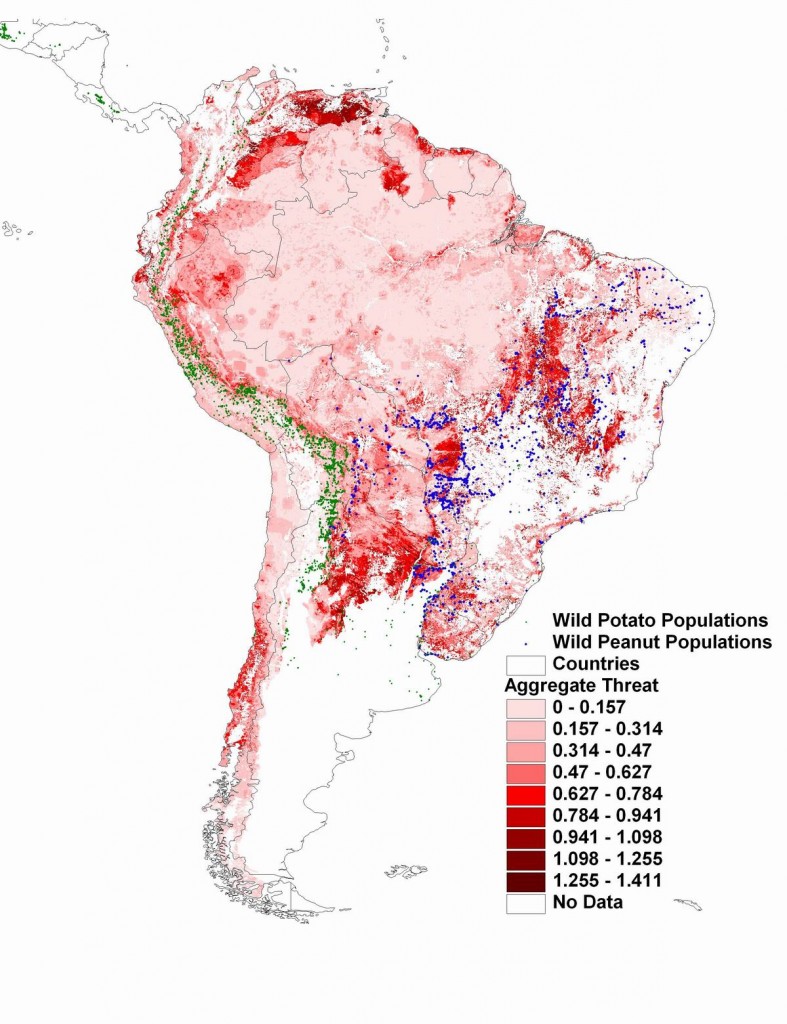Our friend Andy Jarvis and co-workers recently published a paper in the Journal for Nature Conservation entitled “Assessment of threats to ecosystems in South America.” Very interesting in its own right, but check out the map below. Andy has very kindly superimposed for us the location of peanut and potato wild relatives on the ecosystem threat map from the paper. A good way to prioritize conservation? You saw it here first.

Bee story with a sting in its tail
We’ve been a bit forgetful lately, not submitting items to Scientia Pro Publica, one of the most popular science blog carnivals around. But that doesn’t mean we’ve ignored the latest edition, at Genetic Inference. There’s a bunch of stuff there on climate change, and a link to a long post on David Roubik’s 17-year quest to understand the impact of African Killer Bees.
We nibbled Science Daily’s take on the original scientific paper, but on an amazingly busy day. So it is good to see Greg Laden take a somewhat longer view. To the press release, which he thoughtfully copies, Laden adds the observation that “the so called “African Killer Bees” are nothing other than the wild version of the honey bee,” and points out that people have a hard time relating loving, gentle European honey bees to these killers out of Africa’s dark heart. The interbreeding of wild and domesticated honeybees restored some aggression to domestic stocks and in the process of “Africanizing” them also boosted their honey-gathering abilities.
Roubik’s study concluded that although there have been swings in populations of various bee species, pollination has not suffered. Local bees, sometimes outcompeted by Africanized honeybees, are finding other flowers to sustain them. Most of the local plants are still doing fine, and some that are favoured by local bee species have even spread. But Roubik also sounded a cautionary note that hinges on the insurance value of plant biodiversity.
Basically we’re seeing ‘scramble competition’ as bees replace a lost source of pollen with pollen from a related plant species that has a similar flowering peak–in less-biodiverse, unprotected areas, bees would not have the same range of options to turn to.
That’s crucial. Roubik studied bees in “Sian Ka’an Biosphere Reserve — a vast area of mature tropical rainforest in Quintana Roo state on the Mexican Yucatan”. With fewer flower species among which to choose, local bees might not do so well. On the other hand, if the flower species aren’t there, they won’t suffer from the loss of local bees.
Nibble: Wild apples, Genetic erosion, Bananas, Cow DNA, Honeybee virus survey, Women and traditional agriculture
- BBC slideshow on the wild apples of Khazakhstan.
- Malawi breeder decries genetic erosion.
- Bananas good for food security in central Africa. Well, yes.
- The ruminant family tree deconstructed.
- Public to help researchers locate wild honeybee colonies in Hawaii.
- “No Pesticides No Foreign Drinks.”
Nibbles: Sheep, Syrup, Antioxidants, Urban flora, Politics, Erosion, Prince, India and climate change
- British hill sheep in trouble.
- Canadian maple syrup in trouble.
- Fruits good for you.
- Native urban plants in trouble. How many crop wild relatives among them?
- “If the world learned to feed itself half a century ago, why are there now more hungry people than ever before?” Er … I dunno. Either-orism?
- “Almost all of the 300 experts at a two-day food forum in Rome this week agreed that between them they had all the answers to how to feed the world in 2050, but doubted they would have the political support to do it.” Alert the media!
- “Erosion of Crop Diversity Worrying“. Malawian plant breeder speaks.
- British wildflowers in trouble, prince says? How many crop wild relatives among them? Does prince know? Care?
- Indian crops in trouble.
Tajikistan to sustain agrobiodiversity in the face of climate change
A Google Alert pointed me to an article in the Times of Central Asia purportedly about a new Global Environment Facility-funded project in Tajikistan intriguingly entitled “Sustaining Agricultural Biodiversity in the Face of Climate Change.” Alas, the article is behind a paywall, so I wont even link to it, but some judicious googling led me to a UNDP press release. Which eventually led me to the project documents. Here are the objectives of the project in brief:
- Strengthened institutional and financial framework for the agro-biodiversity conservation and joint use of the benefits of the sustainable use of the agro-ecosystems.
- Increased mechanism of co-operation with local communities on agro-ecosystem management including the traditional knowledge of conservation.
- Ecosystem-based conservation and management of wild crop relatives established in the selected territories/communities.
- Lessons and experiences from target Jamoats created conditions for replication and expansion of conservation programmes.
A bunch of “possible interventions” are listed under each of these headings, but it’s unclear to me from the documents that are available online what will actually be done. This may be a project to write a bigger project. I just don’t know enough about how GEF works. If you know more, drop us a line.